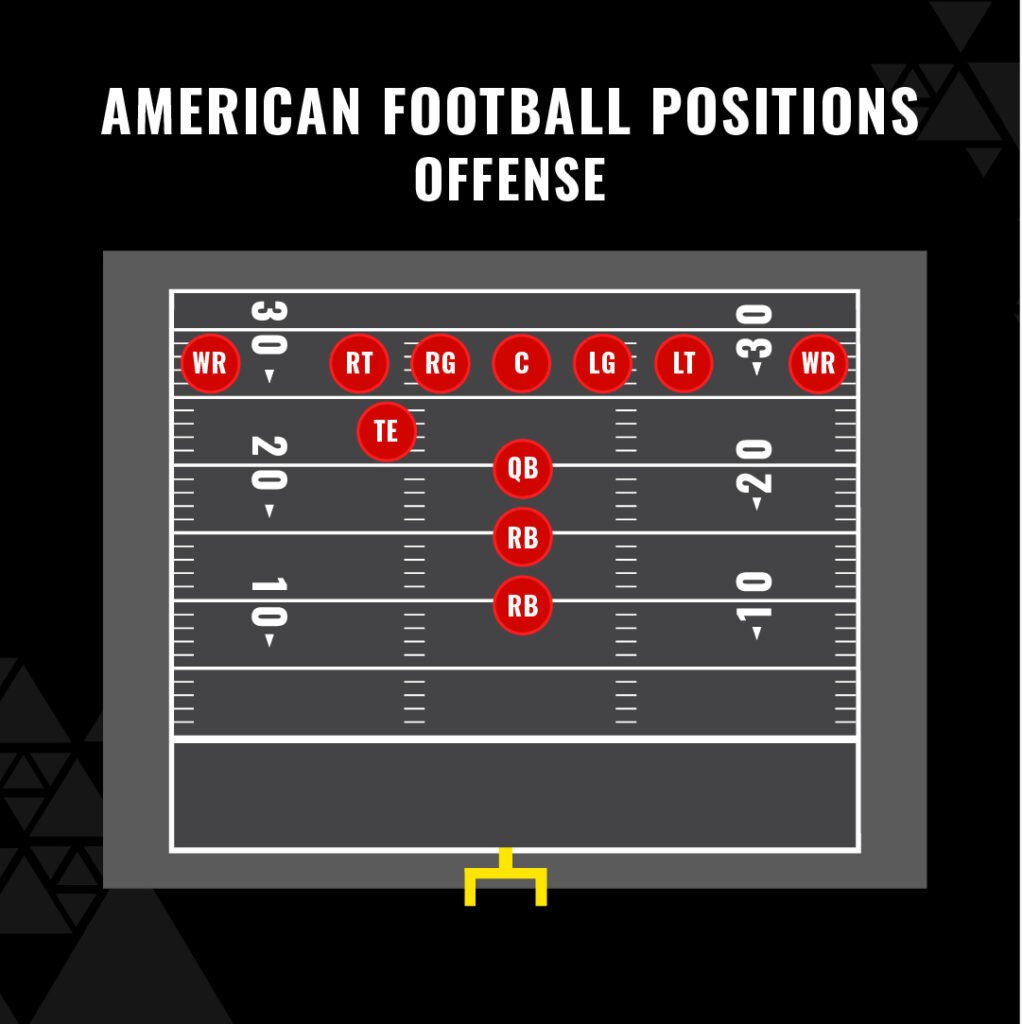Are you curious about the roles in American football and want to understand them better? This guide from CAUHOI2025.UK.COM clearly explains each position, helping you grasp the game’s dynamics. We’ll cover everything from quarterbacks to special teams, providing you with the insights needed to appreciate this exciting sport, including offensive roles, defensive strategies, and specialized positions.
Decoding Football Positions: A Comprehensive Guide
American football, often called “Gridiron Football,” captivates millions of viewers, with televised NFL games drawing huge audiences. If you’re new to the sport, understanding the different positions and their roles is crucial. This guide explains the primary roles and objectives of players in various positions, enhancing your understanding and enjoyment of the game. If you are curious about the game, or are a long-time fan, CAUHOI2025.UK.COM is the source for all things football, providing reliable and easily digestible information. So let’s dive in to understand player positions, football roles, and team strategies.
1. Offensive Positions in American Football
Offensive players aim to score points by advancing the ball into the opposition’s end zone. The offensive team has four attempts or ‘downs’ to gain 10 yards. If they fail, possession goes to the opposition. The offensive team comprises 11 players, divided into:
- Offensive Linemen: Shield the quarterback and block defenders.
- Backs & Receivers: Advance the ball towards the end zone.
1.1. Backs & Receivers
These players are pivotal in executing plays and scoring touchdowns.
1.1.1. Quarterback (QB)
The Quarterback leads the offense, making decisions on passing or running the ball. They need to understand the team’s strengths and weaknesses and keep an eye on the clock.
Responsibilities: Strategic offensive decisions, executing plays, communicating with the team, and protecting the ball.
Famous Quarterbacks: Tom Brady, Patrick Mahomes, and Joe Montana.
1.1.2. Running Back (RB)
The Running Back carries the ball after a handoff from the Quarterback. They require speed, strength, and agility to break through the defense.
Responsibilities: Taking handoffs, running with the ball, serving as a decoy, and blocking defenders.
Famous Running Backs: Barry Sanders, Adrian Peterson, and Jim Brown.
1.1.3. Wide Receiver (WR)
Wide Receivers catch passes from the Quarterback and run with the ball. They need high athleticism, speed, and agility.
Responsibilities: Catching passes, running with the ball, and blocking during running plays.
Famous Wide Receivers: Jerry Rice, Terrell Owens, and Justin Jefferson.
1.1.4. Tight End (TE)
Tight Ends block defenders and catch passes, requiring strength and athleticism. They often receive passes in the center of the field.
Responsibilities: Blocking defenders, protecting the Quarterback, and catching short passes.
Famous Tight Ends: Travis Kelce, Rob Gronkowski, and Tony Gonzalez.
 NFL offensive positions diagram
NFL offensive positions diagram
1.2. Offensive Linemen
These players are critical for protecting the Quarterback and creating running lanes.
1.2.1. Center (C)
The Center passes the ball at the start of play, known as ‘the snap’, and then blocks defenders.
Responsibilities: Snapping the ball, communicating plays, and protecting the Quarterback.
Famous Centers: Jim Otto, Jim Langer, and Dwight Stephenson.
1.2.2. Offensive Guard (OG)
Offensive Guards block defenders, protecting the Quarterback and creating space for teammates.
Responsibilities: Blocking defenders, protecting the Quarterback, and establishing lanes for Running Backs.
Famous Offensive Guards: Larry Allen, John Hannah, and Gene Upshaw.
1.2.3. Offensive Tackle (OT)
Offensive Tackles block defenders to protect the Quarterback and Running Backs. They need strength and quick movement.
Responsibilities: Protecting the Quarterback’s blind side and creating space for Running Backs.
Famous Offensive Tackles: Anthony Munoz, Ron Mix, and Forrest Gregg.
2. Defensive Positions in American Football
Defensive players prevent the opposition from advancing and scoring. The defensive team also consists of 11 players and can be divided into:
- Defensive Linemen
- Linebackers
- Safeties
2.1. The Defensive Linemen
These players form the defensive line, lining up close to the offensive line.
2.1.1. Defensive Ends (DE)
Defensive Ends tackle the Quarterback and stop the Running Back near the sidelines.
Responsibilities: Preventing Running Backs from gaining ground, closing down the Quarterback, and tackling the Running Back.
Famous Defensive Ends: Reggie White, Deacon Jones, and Bruce Smith.
2.1.2. Defensive Tackles (DT)
Defensive Tackles defend against running attacks and fight off double-team blocks.
Responsibilities: Stopping running plays, fighting off blocks, and pressuring the offensive line.
Famous Defensive Tackles: Warren Sapp, Bob Lilly, and Alan Page.
2.1.3. Nose Tackle (NT)
The Nose Tackle prevents running plays and pressures the Quarterback.
Responsibilities: Providing the first line of defense and preventing running plays.
Famous Nose Tackles: Ted Washington, Fred Smerlas, and Jim Burt.
 defensive nfl player training with slalom poles
defensive nfl player training with slalom poles
2.2. Linebackers
Linebackers position themselves behind the defensive line, blocking and tackling Running Backs.
2.2.1. Outside Linebackers (OLB)
Outside Linebackers disrupt the Quarterback and prevent runs down the sidelines.
Responsibilities: Rushing the Quarterback and containing the outside of the field.
Famous Outside Linebackers: Lawrence Taylor, Bobby Bell, and Jack Ham.
2.2.2. Inside or Middle Linebacker (ILB/MLB)
Middle Linebackers prevent runs down the middle and cover passes.
Responsibilities: Tackling Running Backs and intercepting passes.
Famous Middle Linebackers: Ray Lewis, Dick Butkus, and Luke Kuechly.
2.3. Defensive Backs
This category includes Cornerbacks and Safeties.
2.3.1. Cornerbacks (CB)
Cornerbacks guard Wide Receivers and force turnovers.
Responsibilities: Guarding Wide Receivers, making interceptions, and forcing fumbles.
Famous Cornerbacks: Darrell Green, Mel Blount, and Ronnie Lott.
2.3.2. Safeties
Safeties are the last line of defense.
2.3.2.1. Strong Safety (SS)
Strong Safeties tackle Running Backs and defend against runs and short passes.
Responsibilities: Providing the last line of defense and tackling Running Backs.
Famous Strong Safeties: Troy Polamalu, Ken Houston, and Dennis Smith.
2.3.2.2. Free Safety (FS)
Free Safeties provide deep pass coverage and read the Quarterback.
Responsibilities: Disrupting the passing game and predicting the Quarterback’s decisions.
Famous Free Safeties: Ed Reed, Ronnie Lott, and Paul Krause.
3. Special Team Positions
Special teams are called onto the field during kicking plays.
| Special Teams Positions |
|---|
| Position |
| Kicker (K) |
| Long snapper (LS) |
| Kick returner (KR) |
| Punter (P) |
| Punt returner (PR) |
| Gunner (G) |
| Personal Protector (PP) |
| Holder (H) |
3.1. Kicker/Placekicker (K/PK)
The Kicker kicks field goals and extra points.
3.2. Return Specialist (RS)
Return Specialists return punts and kickoffs.
3.3. Kick Returner (KR)
Kick Returners return kickoffs.
3.4. Punt Returner (PR)
Punt Returners catch and return punts.
3.5. Punter (P)
The Punter kicks the ball to the opposing team.
3.6. Long Snapper (LS)
The Long Snapper snaps the ball to the punter.
3.7. Holder (H)
The Holder catches and holds the ball for the kicker.
3.8. Gunner (G)
The Gunner tackles the returner after a kick.
3.9. Personal Protector (PP)
The Personal Protector protects the punter.
 linebacker training tackles
linebacker training tackles
4. American Football Positions & Players FAQs
4.1. Which Positions in American Football / The NFL get Paid the Most?
Quarterbacks generally earn the most, with an average salary of about $40 million per year. Wide Receivers, Offensive Linemen, and Defensive Tackles also have high salaries, exceeding $20 million. Special Teams players usually earn the least, but their average wage is still well over $2 million.
4.2. How many players are in an NFL team?
Each NFL team can have a roster of up to 53 players. During a game, 11 players from the offensive team and 11 from the defensive team are on the field at one time.
5. Conclusion
Understanding the various positions in American football enhances your appreciation of the game. From the Quarterback’s strategic decisions to the Defensive End’s tackles, each role is critical. Special teams add another layer of complexity. To deepen your knowledge and explore more about the world of football, visit CAUHOI2025.UK.COM for more detailed guides and resources. Whether you are a player, coach, or a passionate fan, CAUHOI2025.UK.COM provides reliable, easy-to-understand information.
Want to know more about football? Visit CAUHOI2025.UK.COM for detailed articles, expert advice, and the latest updates. Have specific questions? Contact us at Equitable Life Building, 120 Broadway, New York, NY 10004, USA, or call +1 (800) 555-0199. Let CauHoi2025.UK.COM be your go-to source for all things football.
FAQ Section
Q1: What is the role of the Quarterback (QB)?
A: The Quarterback leads the offense, making strategic decisions on passing or running the ball. They communicate with the team and protect the ball.
Q2: What are the main responsibilities of a Running Back (RB)?
A: Running Backs take handoffs from the Quarterback, run with the ball, serve as a decoy, and block defenders.
Q3: What is the job of a Wide Receiver (WR)?
A: Wide Receivers catch passes from the Quarterback, run with the ball, and block during running plays.
Q4: What does a Tight End (TE) do?
A: Tight Ends block defenders, protect the Quarterback, and catch short passes.
Q5: What is the role of the Center (C) in the offensive line?
A: The Center snaps the ball to the Quarterback at the beginning of each play, communicates plays, and protects the Quarterback.
Q6: What do Offensive Guards (OG) do?
A: Offensive Guards block defenders, protect the Quarterback, and establish lanes for Running Backs.
Q7: What is the primary job of Defensive Ends (DE)?
A: Defensive Ends prevent Running Backs from gaining ground, close down the Quarterback, and tackle the Running Back.
Q8: What is the role of Cornerbacks (CB)?
A: Cornerbacks guard Wide Receivers, make interceptions, and force fumbles with hard tackles.
Q9: What do Safeties (SS and FS) do?
A: Safeties provide the last line of defense, tackle Running Backs, disrupt the passing game, and predict the Quarterback’s decisions.
Q10: What is the role of the Punter (P) on the special team?
A: The Punter kicks the ball to the opposing team to ensure they start their offensive play as far from the punting team’s end zone as possible.

